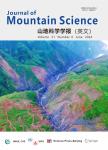Numerical simulation of mud-flows impacting structures
Numerical simulation of mud-flows impacting structures作者机构:DICEA Università di Napoli Federico II DI Università della Campania Luigi Vanvitelli
出 版 物:《Journal of Mountain Science》 (山地科学学报(英文))
年 卷 期:2019年第16卷第2期
页 面:364-382页
核心收录:
学科分类:0709[理学-地质学] 0819[工学-矿业工程] 08[工学] 0303[法学-社会学] 0818[工学-地质资源与地质工程] 0708[理学-地球物理学] 0705[理学-地理学] 0815[工学-水利工程] 0837[工学-安全科学与工程] 0816[工学-测绘科学与技术] 0706[理学-大气科学] 0813[工学-建筑学] 0704[理学-天文学] 0833[工学-城乡规划学] 0713[理学-生态学] 0834[工学-风景园林学(可授工学、农学学位)]
基 金:the framework of the project MISALVA financed by the Italian Minister of the Environment Land Protection and Sea.CUP H36C18000970005
主 题:Mud-Flow Impact force Two-phase model Power-law
摘 要:The study of the interaction of mud-flows with obstacles is important to define inundation zones in urban areas and to design the possible structural countermeasures. The paper numerically investigates the impact of a mud-flow on rigid obstacles to evaluate the force acting on them using two different depth-integrated theoretical models, Single-Phase Model(SPM) and Two-Phase Model(TPM), to compare their performance and limits. In the first one the water-sediment mixture is represented as a homogeneous continuum described by a shearthinning power-law rheology. Alternatively, the twophase model proposed by Di Cristo et al in 2016 is used, which separately accounts for the liquid and solid phases. The considered test cases are represented by a 1D landslide flowing on a steep slope impacting on a rigid wall and a 2D mud dam-break flowing on a horizontal bottom in presence of single and multiple rigid obstacles. In the 1D test case, characterized by a very steep slope, the Two-Phase Model predicts the separation between the two phases with a significant longitudinal variation of the solid concentration. In this case the results indicate appreciable differences between the two models in the estimation of both the wave celerity and the magnitude of the impact, with an overestimation of the peak force when using the Single-Phase Model. In the 2D test-cases, where the liquid and solid phases remain mixed, even if the flow fields predicted by the two models present some differences, the essential features of the interaction with the obstacles, along with the maximum impact force, are comparable.



